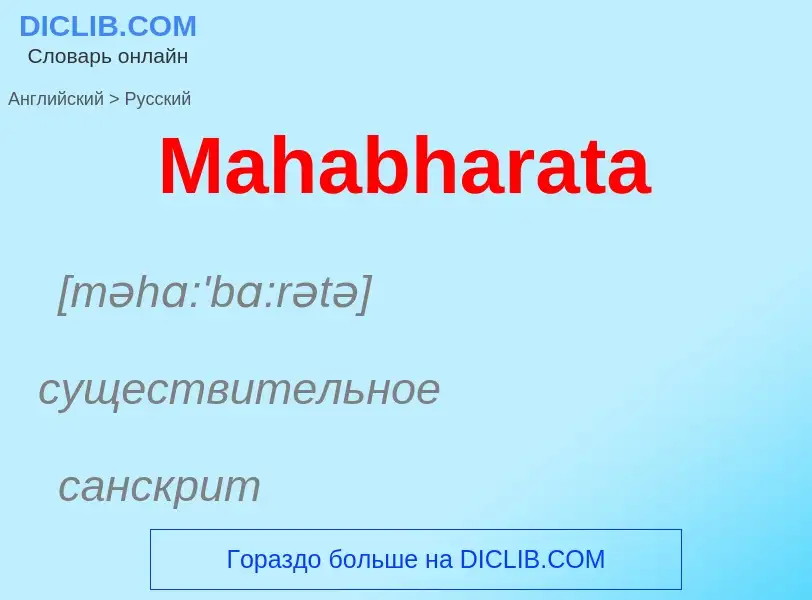Перевод и анализ слов искусственным интеллектом ChatGPT
На этой странице Вы можете получить подробный анализ слова или словосочетания, произведенный с помощью лучшей на сегодняшний день технологии искусственного интеллекта:
- как употребляется слово
- частота употребления
- используется оно чаще в устной или письменной речи
- варианты перевода слова
- примеры употребления (несколько фраз с переводом)
- этимология
Mahabharata - перевод на русский
[məhɑ:'bɑ:rətə]
существительное
санскрит
Махабхарата (древнеиндийский эпос)
Определение

Википедия

The Mahābhārata ( mə-HAH-BAR-ə-tə, MAH-hə-; Sanskrit: महाभारतम्, Mahābhāratam, pronounced [mɐɦaːˈbʱaːrɐt̪ɐm]) is one of the two major Sanskrit epics of ancient India in Hinduism, the other being the Rāmāyaṇa. It narrates the struggle between two groups of cousins in the Kurukshetra War and the fates of the Kaurava and the Pāṇḍava princes and their successors.
It also contains philosophical and devotional material, such as a discussion of the four "goals of life" or puruṣārtha (12.161). Among the principal works and stories in the Mahābhārata are the Bhagavad Gita, the story of Damayanti, the story of Shakuntala, the story of Pururava and Urvashi, the story of Savitri and Satyavan, the story of Kacha and Devayani, the story of Rishyasringa and an abbreviated version of the Rāmāyaṇa, often considered as works in their own right.
Traditionally, the authorship of the Mahābhārata is attributed to Vyāsa. There have been many attempts to unravel its historical growth and compositional layers. The bulk of the Mahābhārata was probably compiled between the 3rd century BCE and the 3rd century CE, with the oldest preserved parts not much older than around 400 BCE. The text probably reached its final form by the early Gupta period (c. 4th century CE).
The Mahābhārata is the longest epic poem known and has been described as "the longest poem ever written". Its longest version consists of over 100,000 śloka or over 200,000 individual verse lines (each shloka is a couplet), and long prose passages. At about 1.8 million words in total, the Mahābhārata is roughly ten times the length of the Iliad and the Odyssey combined, or about four times the length of the Rāmāyaṇa. W. J. Johnson has compared the importance of the Mahābhārata in the context of world civilization to that of the Bible, the Quran, the works of Homer, Greek drama, or the works of William Shakespeare. Within the Indian tradition it is sometimes called the fifth Veda.



![Krishna as portrayed in [[Yakshagana]] from [[Karnataka]] which is based largely on stories of ''Mahabharata'' Krishna as portrayed in [[Yakshagana]] from [[Karnataka]] which is based largely on stories of ''Mahabharata''](https://commons.wikimedia.org/wiki/Special:FilePath/FullPagadeYakshagana.jpg?width=200)
![[[Krishna]] and [[Arjuna]] at [[Kurukshetra]], 18th–19th-century painting. [[Krishna]] and [[Arjuna]] at [[Kurukshetra]], 18th–19th-century painting.](https://commons.wikimedia.org/wiki/Special:FilePath/Krishna and Arjun on the chariot, Mahabharata, 18th-19th century, India.jpg?width=200)
![The god Krishna acts as a charioteer to Arjuna in the battle of the Bhagavad Gita, a section of the Mahabharata. Taken from an illustrated manuscript scroll, 1795 C.E. held in the [https://images.is.ed.ac.uk/luna/servlet/detail/UoE~3~3~210~198024:Mahabharata-Scroll-Section-134?qvq=q:LIMIT%3A%20UoE~3~3;lc:UoE~3~3&mi=253&trs=264 archive collection] at the University of Edinburgh, Scotland. The god Krishna acts as a charioteer to Arjuna in the battle of the Bhagavad Gita, a section of the Mahabharata. Taken from an illustrated manuscript scroll, 1795 C.E. held in the [https://images.is.ed.ac.uk/luna/servlet/detail/UoE~3~3~210~198024:Mahabharata-Scroll-Section-134?qvq=q:LIMIT%3A%20UoE~3~3;lc:UoE~3~3&mi=253&trs=264 archive collection] at the University of Edinburgh, Scotland.](https://commons.wikimedia.org/wiki/Special:FilePath/M 134 Short.png?width=200)




![[[Arjuna]] piercing the eye of the fish as depicted in [[Chennakesava Temple]] built by [[Hoysala Empire]] [[Arjuna]] piercing the eye of the fish as depicted in [[Chennakesava Temple]] built by [[Hoysala Empire]]](https://commons.wikimedia.org/wiki/Special:FilePath/Swayamvara Draupadi Arjuna Archery.jpg?width=200)
![Persian]] translation of the ''Mahabharata'' Persian]] translation of the ''Mahabharata''](https://commons.wikimedia.org/wiki/Special:FilePath/Totheforest.jpg?width=200)

